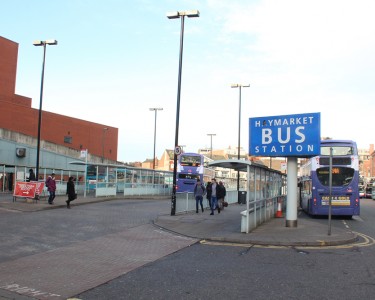Leicester’s St Margaret’s Bus Station has been transformed into a multi-million-pound net zero carbon station.
The building, which opened today (Monday, June 27), was almost completely demolished and stripped back to its partial steelwork frame that was reused in line with the high eco-standards of the project.
By reusing major elements of the previous building and retaining and repairing the existing concrete on the main area for bus arrivals and departures, the ‘embodied’ carbon cost of constructing the new building has been dramatically reduced by an equivalent of over 575 tonnes.
Around 20 local bus services – which have been operating from temporary stops throughout the 18 months of construction – returned to the new building today.
It features a glazed concourse to maximise natural lighting and cut energy consumption and a curved aluminium roof where a solar array of 390 photovoltaic panels will generate more clean, green power than is needed to run the building.
The building has an Energy Performance Certificate (EPC) with the highest possible rating of A+ and a score of -4. This means that the new bus station building will be better than net zero carbon in terms of its operational emissions.
Deputy city mayor Cllr Adam Clarke, who leads on environment and transportation, said that the new station represents “an ambitious and important step forwards in Leicester’s efforts to become a carbon neutral city.”
“Over the last 18 months, bus passengers have had to be really patient with us, but what we think has happened here, is something truly special, truly unique and a UK first in that we have developed the country’s first net zero carbon bus station,” he said of the new development.
“What we have here is what I think is a world class facility, it feels and looks a bit like an airport lounge. But the best thing about it is, that it’s incredibly energy efficient. It’s got an A plus rating in terms of its environmental performance and it is saving Carbon and also saving money as well”, he added.
“What I hope is that this will be a real flip for buses in Leicester. People will want to use buses in Leicester because we’re providing the best possible facility for residents of the city.”
Other highlights of the new building construction, include a “more spacious internal layout”, and more capacity for national and regional services, with the number of available bays increased by a third from 18 to 24.
Electric bus charging points have been installed and the new building will offer secure storage for up to 100 bicycles, as well being the latest location for a docking station as part of the city’s new e-bike share scheme, Santander Cycles Leicester.
Improvements to footpaths and roads next to the bus station are also complete. These include new and improved facilities for cyclists and pedestrians, safer crossings, new landscaping and more tree planting.
The work will help strengthen and improve links between key development sites and the city centre, including the new Savoy Street which will provide a quick, direct pedestrian route link between St Margaret’s and Haymarket bus stations, say Leicester City Council.
Asked her opinion about the new facility, Rothley resident Angela told Pukaar News that the improvements would definitely encourage her to use the bus more.
“It’s a massive improvement on the original one”, she said of the station.
“It looks a lot cleaner, it looks a lot more airy. It just looks a whole lot smarter than the old one.”
Sileby resident Sam praised the bus station’s aesthetic and also the eco friendly elements of the design.
“It’s a lot more eco friendly, so I think that’s good for the environment, and also good for the city as well”, she said.
“The old bus station was quite run down, and I think it just needed that once over. I think it’ll just do great for the city, and will bring more tourism as well. It just looks absolutely fantastic.”
The bus station redevelopment is part of the £14.3million St Margaret’s Gateway regeneration project. This has been supported by a £10.5million allocation from the Getting Building Fund, a pot of government money awarded to the Leicester and Leicestershire Enterprise Partnership (LLEP) for shovel-ready infrastructure projects to help create jobs and support economic recovery across the country.







